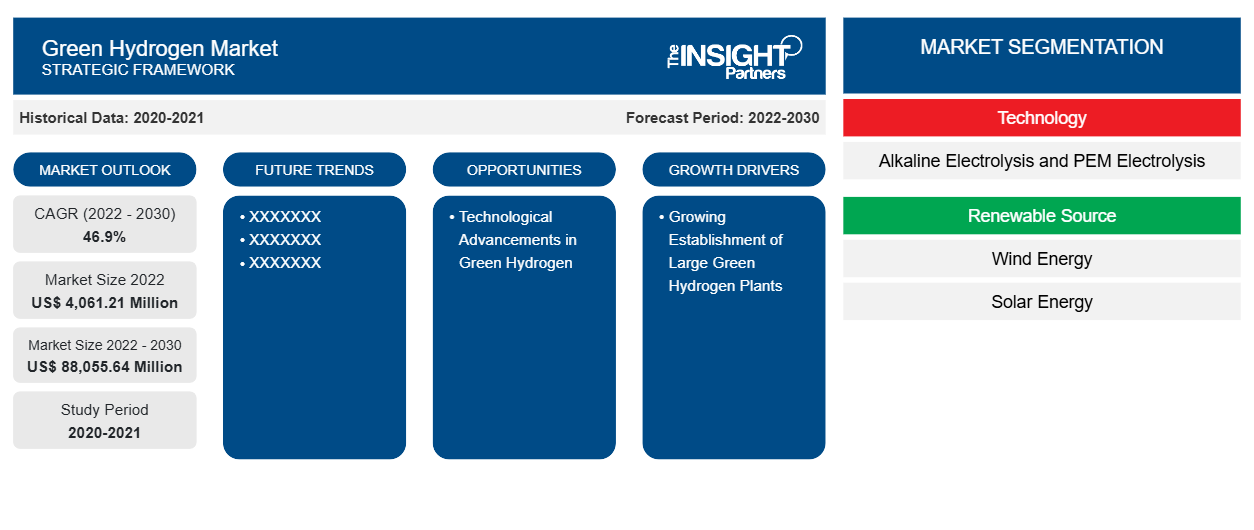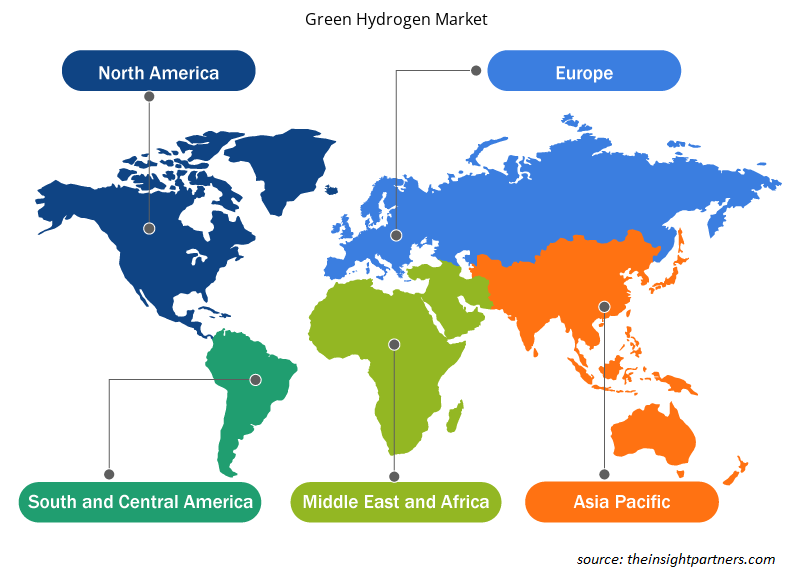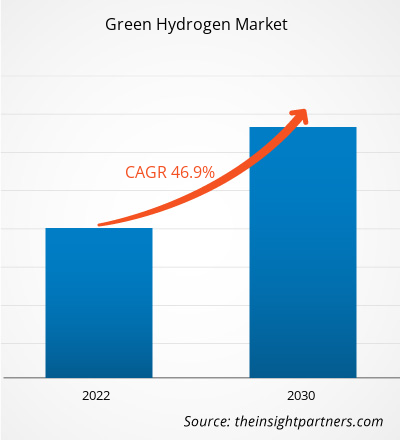Der Markt für grünen Wasserstoff dürfte von 8,38 Milliarden US-Dollar im Jahr 2024 auf 71,31 Milliarden US-Dollar im Jahr 2031 wachsen; von 2025 bis 2031 wird eine durchschnittliche jährliche Wachstumsrate (CAGR) von 37,8 % erwartet. Die deutlich steigenden staatlichen Investitionen in erneuerbare Energien dürften ein wichtiger Trend auf dem Markt für grünen Wasserstoff bleiben.
Marktanalyse für grünen Wasserstoff
Regierungen weltweit erkennen die Vorteile von grünem Wasserstoff als saubere und nachhaltige Energielösung. Sie ergreifen proaktive Maßnahmen, um dessen Entwicklung und Einsatz in verschiedenen Sektoren zu unterstützen. Der zunehmende Fokus auf Dekarbonisierung und Klimaschutz veranlasst Regierungen, Investitionen in grünen Wasserstoff als Mittel zur Reduzierung der CO2-Emissionen zu priorisieren. So stellte beispielsweise Protium, eines der führenden Unternehmen für grüne Wasserstoffenergie in Großbritannien, im Juni 2022 durchgängige Netto-Null-Energielösungen bereit. Daher wird erwartet, dass steigende Investitionen in grüne Wasserstoffprojekte in den kommenden Jahren lohnende Möglichkeiten zur Marktexpansion schaffen.
Marktübersicht für grünen Wasserstoff
Elektrolyse dient zur Erzeugung von grünem Wasserstoff durch die Trennung von Wassermolekülen in Sauerstoff und Wasserstoff mithilfe von Elektrizität. Technologische Fortschritte in der Elektrolyse tragen dazu bei, die Effizienz, Wirtschaftlichkeit und Skalierbarkeit der Produktion, Speicherung und Nutzung von grünem Wasserstoff zu verbessern. Verbesserte Elektrolyseur-Designs, fortschrittliche Katalysatormaterialien und optimierte Betriebsbedingungen sind einige Faktoren, die zu höheren Energieumwandlungswirkungsgraden, kürzeren Reaktionszeiten und einer längeren Lebensdauer der Geräte führen können. Im Juli 2023 präsentierte das Korea Research Institute of Standards & Science (KRISS) eine potenzielle Lösung für den langlebigen und effizienten Ladungsträgertransport einer Photoanode mit Schutzfolie zur Entwicklung der Produktion von grünem Wasserstoff. Solche Fortschritte erweitern auch das Anwendungsspektrum von grünem Wasserstoff. Daher wird erwartet, dass technologische Fortschritte im Zusammenhang mit grünem Wasserstoff das Marktwachstum im Prognosezeitraum vorantreiben werden.
Passen Sie diesen Bericht Ihren Anforderungen an
Sie erhalten kostenlos Anpassungen an jedem Bericht, einschließlich Teilen dieses Berichts oder einer Analyse auf Länderebene, eines Excel-Datenpakets sowie tolle Angebote und Rabatte für Start-ups und Universitäten
Markt für grünen Wasserstoff: Strategische Einblicke

-
Informieren Sie sich über die wichtigsten Markttrends in diesem Bericht.Dieses KOSTENLOSE Beispiel umfasst Datenanalysen, von Markttrends bis hin zu Schätzungen und Prognosen.
Treiber und Chancen des Marktes für grünen Wasserstoff
Steigende Nachfrage nach FCEV begünstigt den Markt
Brennstoffzellen-Elektrofahrzeuge (FCEVs) nutzen Wasserstoff als Kraftstoff und erzeugen mithilfe von Brennstoffzellen Strom. Sie bieten eine saubere und leistungsstarke Alternative zu herkömmlichen Fahrzeugen mit Verbrennungsmotor. Da Länder bestrebt sind, ihre CO2-Emissionen zu reduzieren und auf kohlenstoffarme Mobilität umzusteigen, steigt die Nachfrage nach FCEVs weltweit. Daher engagieren sich verschiedene Marktteilnehmer in strategischen Entwicklungen wie Partnerschaften, Kooperationen und Vereinbarungen, um ihr Produktangebot zu erweitern und die wachsende Nachfrage nach FCEVs zu decken. Die Einführung von FCEVs treibt den Bedarf an grüner Wasserstoffproduktion voran, da dieser die primäre Kraftstoffquelle dieser Fahrzeuge darstellt.
Zunehmende Errichtung großer Anlagen zur Erzeugung von grünem Wasserstoff – eine Chance auf dem Markt für grünen Wasserstoff
Der Bau großer Anlagen zur Erzeugung von grünem Wasserstoff zieht erhebliche Investitionen sowohl aus dem öffentlichen als auch aus dem privaten Sektor an. Im Juni 2023 kündigte eine Unternehmensgruppe an, 79,75 US-Dollar in ein Projekt zur Erweiterung einer Wasserstoffproduktionsanlage und einer Wasserstoffverflüssigungsanlage in Queensland, Australien, zu investieren. Zu der Unternehmensgruppe gehören die Kansai Electric Power Company (Japan), die Marubeni Corporation (Japan), die Iwatani Corporation (Japan), die Keppel Infrastructure (Singapur) und die Stanwell Corporation (Australien). Der verstärkte Infrastrukturausbau dürfte ein positives Umfeld für die Einführung von grünem Wasserstoff in verschiedenen Sektoren schaffen und den Marktteilnehmern im Prognosezeitraum voraussichtlich Wachstumsaussichten bieten.
Segmentierungsanalyse des Marktberichts für grünen Wasserstoff
Wichtige Segmente, die zur Ableitung der Marktanalyse für grünen Wasserstoff beigetragen haben , sind Technologie, erneuerbare Quellen und Endverbrauch.
- Basierend auf der Technologie wurde der Markt für grünen Wasserstoff in alkalische Elektrolyse und PEM-Elektrolyse unterteilt. Das Segment der alkalischen Elektrolyse hatte im Jahr 2022 einen größeren Marktanteil.
- Im Hinblick auf erneuerbare Energien wurde der Markt in Windenergie, Solarenergie und andere segmentiert. Das Segment Solarenergie dominierte den Markt im Jahr 2022.
- In Bezug auf die Endverbrauchsindustrie wurde der Markt in die Branchen Chemie, Energie, Lebensmittel und Getränke, Medizin, Petrochemie und andere segmentiert. Das Energiesegment dominierte den Markt im Jahr 2022.
Analyse der Marktanteile von grünem Wasserstoff nach geografischen Gesichtspunkten
Der geografische Umfang des Marktberichts für grünen Wasserstoff ist hauptsächlich in fünf Regionen unterteilt: Nordamerika, Asien-Pazifik, Europa, Naher Osten und Afrika sowie Südamerika/Süd- und Mittelamerika.
Europa ist führend auf dem Markt für grünen Wasserstoff. Mehrere europäische Länder, darunter Spanien, Frankreich, Deutschland und Portugal, haben Schritte unternommen, um zusammenzuarbeiten und bis 2030 eine Wasserstoffpipeline zu bauen. Diese Pipeline wird den Transport von jährlich ca. 2 Millionen Tonnen Wasserstoff von diesen Ländern nach Frankreich ermöglichen. Da Europa seine Energieversorgung sichern und den Übergang zu einer kohlenstoffneutralen Zukunft beschleunigen möchte, erweist sich grüner Wasserstoff als unverzichtbare Ressource und Schlüssellösung, um die Abhängigkeit von fossilen Brennstoffen zu reduzieren und ehrgeizige Klimaziele zu erreichen. Deutschland, Frankreich, Italien und Großbritannien gehören zu den führenden Ländern auf dem Markt für grünen Wasserstoff in Europa. Die deutsche Regierung hat bereits Schritte zur Förderung der Wasserstoffwirtschaft unternommen, darunter die Verabschiedung einer Nationalen Wasserstoffstrategie. So kündigte Deutschland im März 2022 an, 572 Millionen US-Dollar zu einer neuen globalen grünen Wasserstoffwirtschaft beizutragen. Dies ist ein wichtiger Schritt, um die Einführung und Entwicklung sauberer Energielösungen weltweit zu fördern.
Regionale Einblicke in den Markt für grünen Wasserstoff
Die Analysten von Insight Partners haben die regionalen Trends und Faktoren, die den Markt für grünen Wasserstoff im Prognosezeitraum beeinflussen, ausführlich erläutert. In diesem Abschnitt werden auch die Marktsegmente und die geografische Lage in Nordamerika, Europa, Asien-Pazifik, dem Nahen Osten und Afrika sowie Süd- und Mittelamerika erörtert.

- Erhalten Sie regionale Daten zum Markt für grünen Wasserstoff
Umfang des Marktberichts über grünen Wasserstoff
| Berichtsattribut | Details |
|---|---|
| Marktgröße im Jahr 2024 | 8,38 Milliarden US-Dollar |
| Marktgröße bis 2031 | 71,31 Milliarden US-Dollar |
| Globale CAGR (2025 – 2031) | 37,8 % |
| Historische Daten | 2021-2023 |
| Prognosezeitraum | 2025–2031 |
| Abgedeckte Segmente |
Nach Technologie
|
| Abgedeckte Regionen und Länder |
Nordamerika
|
| Marktführer und wichtige Unternehmensprofile |
|
Marktdichte für grünen Wasserstoff: Auswirkungen auf die Geschäftsdynamik
Der Markt für grünen Wasserstoff wächst rasant. Die steigende Endverbrauchernachfrage ist auf Faktoren wie veränderte Verbraucherpräferenzen, technologische Fortschritte und ein stärkeres Bewusstsein für die Produktvorteile zurückzuführen. Mit der steigenden Nachfrage erweitern Unternehmen ihr Angebot, entwickeln Innovationen, um den Verbraucherbedürfnissen gerecht zu werden, und nutzen neue Trends, was das Marktwachstum weiter ankurbelt.
Die Marktteilnehmerdichte beschreibt die Verteilung der in einem bestimmten Markt oder einer bestimmten Branche tätigen Unternehmen. Sie gibt an, wie viele Wettbewerber (Marktteilnehmer) in einem bestimmten Marktraum im Verhältnis zu dessen Größe oder Gesamtmarktwert präsent sind.
Die wichtigsten Unternehmen, die auf dem Markt für grünen Wasserstoff tätig sind, sind:
- Air Liquide
- Siemens Energy
- Cummins Inc.
- Linde Plc
- NEL ASA
- ?rsted A/S
Haftungsausschluss : Die oben aufgeführten Unternehmen sind nicht in einer bestimmten Reihenfolge aufgeführt.

- Überblick über die wichtigsten Akteure auf dem Markt für grünen Wasserstoff
Neuigkeiten und aktuelle Entwicklungen zum Markt für grünen Wasserstoff
Der Markt für grünen Wasserstoff wird durch die Erhebung qualitativer und quantitativer Daten aus Primär- und Sekundärforschung bewertet, die wichtige Unternehmenspublikationen, Verbandsdaten und Datenbanken umfasst. Im Folgenden finden Sie eine Liste der Entwicklungen im Markt für Innovationen, Geschäftserweiterungen und Strategien:
- Im Oktober 2022 unterzeichneten NTPC und Siemens Ltd. eine Absichtserklärung (MoU) zur Demonstration der Mitverbrennung von Wasserstoff mit Erdgas in Siemens V94.2-Gasturbinen im NTPC-Gaskraftwerk Faridabad. (Quelle: Siemens Ltd., Pressemitteilung/Unternehmenswebsite/Newsletter)
- Im Dezember 2022 lieferte Cummins Inc. ein 35-Megawatt-Protonenaustauschmembran-Elektrolyseursystem (PEM) für Lindes neue Wasserstoffproduktionsanlage in Niagara Falls, New York. (Quelle: Cummins Inc., Pressemitteilung/Unternehmenswebsite/Newsletter)
Marktbericht zu grünem Wasserstoff – Umfang und Ergebnisse
Der Bericht „Marktgröße und Prognose für grünen Wasserstoff (2020–2030)“ bietet eine detaillierte Analyse des Marktes, die die folgenden Bereiche abdeckt:
- Marktgröße und Prognose für grünen Wasserstoff auf globaler, regionaler und Länderebene für alle wichtigen Marktsegmente, die im Rahmen des Berichts abgedeckt sind
- Marktdynamik wie Treiber, Hemmnisse und wichtige Chancen
- Markttrends für grünen Wasserstoff
- Detaillierte PEST- und SWOT-Analyse
- Marktanalyse für grünen Wasserstoff mit wichtigen Markttrends, globalen und regionalen Rahmenbedingungen, wichtigen Akteuren, Vorschriften und aktuellen Marktentwicklungen
- Markt für grünen Wasserstoff: Branchen-, Landschafts- und Wettbewerbsanalyse, einschließlich Marktkonzentration, Heatmap-Analyse, prominenten Akteuren und jüngsten Entwicklungen
- Detaillierte Firmenprofile
- Historische Analyse (2 Jahre), Basisjahr, Prognose (7 Jahre) mit CAGR
- PEST- und SWOT-Analyse
- Marktgröße Wert/Volumen – Global, Regional, Land
- Branchen- und Wettbewerbslandschaft
- Excel-Datensatz
Aktuelle Berichte
Erfahrungsberichte
Grund zum Kauf
- Fundierte Entscheidungsfindung
- Marktdynamik verstehen
- Wettbewerbsanalyse
- Kundeneinblicke
- Marktprognosen
- Risikominimierung
- Strategische Planung
- Investitionsbegründung
- Identifizierung neuer Märkte
- Verbesserung von Marketingstrategien
- Steigerung der Betriebseffizienz
- Anpassung an regulatorische Trends






















 Kostenlose Probe anfordern für - Markt für grünen Wasserstoff
Kostenlose Probe anfordern für - Markt für grünen Wasserstoff